Dutch Elm Disease Appearance�� | |
|---|---|
| June 19, 2006 | |
|
Dutch elm disease (DED) appears annually in Illinois. The University of Illinois Plant Clinic has positive cases every year; and the Morton Arboretum in Lisle reports recent removals of infected trees. The beetle vectors of Dutch elm disease (DED) were introduced from Europe; and later, in the 1920s, the fungal pathogen, Ophiostoma ulmi, was introduced via imported elm logs from Europe. This marked the start of the Dutch elm disease epidemic. Over the years, this disease has spread across the United States and killed over 40 million elm trees. The large number of tree fatalities was attributed to the fact that they were often planted in monocultures. This meant that the DED pathogen was easily disseminated between closely spaced trees by root grafts or insect vectors. We still see the disease, probably on trees that escaped earlier infection. The Dutch elm pathogen survives the winter on the inside and outside of elm bark, so removal of infected trees is important in managing the disease. The pathogen can be spread by native elm bark beetles or introduced European bark beetles. The beetles feed, lay eggs, hatch from eggs, and create a series of tunnels or galleries in the wood. The adult beetles eventually emerge from the trees and carry the sticky spores of the DED fungus to healthy elm trees. DED infections that occur in the spring or early summer are considered to be serious because the pathogen can spread more rapidly throughout the springwood, which is composed of very long xylem vessels. Infection that occurs later in the season is spread more slowly throughout the summerwood, which is composed of shorter xylem vessels. The Dutch elm fungus induces a hormonal imbalance in the tree that leads to the production of tyloses that block xylem cells. Brown streaks or discoloration just under the bark of infected trees is the result of tyloses production.This vascular discoloration can be seen in the image below. The three branch sections pictured have been stripped of bark. The branch on the left is healthy. The other two are infected with the DED fungus.  DED fungi also produce toxins or enzymes that kill xylem parenchyma cells. This causes the yellowing, wilting, or flagging of leaves on separate branches throughout the crown of the tree. DED fungi also produce toxins or enzymes that kill xylem parenchyma cells. This causes the yellowing, wilting, or flagging of leaves on separate branches throughout the crown of the tree. Positive identification of DED requires culturing and identification of the causal fungus. Cultures are done with live wood taken from symptomatic branches showing vascular streaking. The ideal branch size is thumb thickness and 6 to 8 inches long. Confirmed DED-infected elms should be immediately removed and destroyed to prevent disease spread. In the past, insecticide applications were used to control the beetle, but these applications were expensive and not very effective. More recently, systemic fungicide injections have been shown to prevent new infections and stop the fungal colonization of uninfected parts of the tree. Still, these fungicides (Alamo and Arbotect) are rather costly and provide no guarantees. Information abut chemical options is provided in the Illinois Commercial Landscape and Turfgrass Pest Management Handbook and the Home, Yard, and Garden Pest Guide. A report about DED can be found on the Internet at http://www.ag.uiuc.edu/%7Evista/horticul.htm or in local U of I Extension offices. (Stephanie Porter and Nancy Pataky)�� | |
| Author: | Nancy Pataky |
